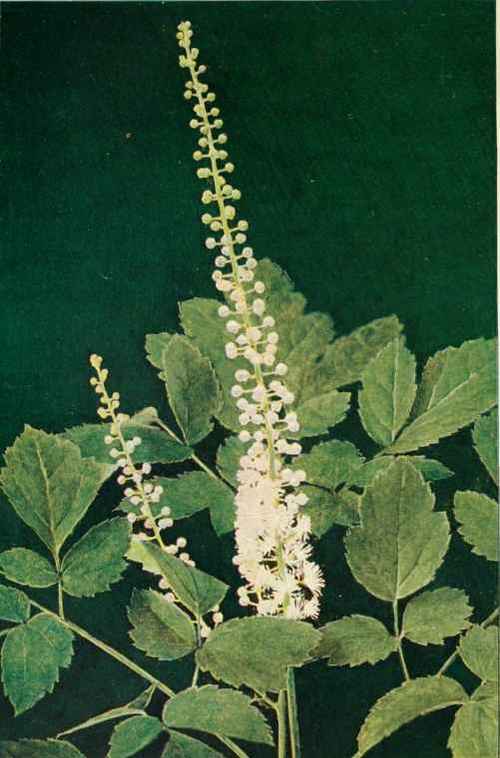Black Cohosh; Black Snakeroot; Tall Bug-Bane (Cimicifuga Racemosa) Crowfoot Family
Description
This section is from the book "Nature's Garden", by Neltje Blanchan. Also available from Amazon: Nature's Garden; An Aid To Knowledge Of Our Wild Flowers And Their Insect Visitors.
Black Cohosh; Black Snakeroot; Tall Bug-Bane (Cimicifuga Racemosa) Crowfoot Family
Flowers - Fetid, feathery, white, in an elongated wand-like raceme, 6 in. to 2 ft. long, at the end of a stem 3 to 8 ft. high. Sepals petal-like, falling early; 4 to 8 small stamen-like petals 2-cleft; stamens very numerous, with long filaments; 1 or 2 sessile pistils with broad stigmas. Leaves: Alternate, on long petioles, thrice compounded of oblong, deeply toothed or cleft leaflets, the end leaflet often again compound. Fruit: Dry oval pods, their seeds in 2 rows.

Black Cohosh. (Cimiclfuga racemosa.)
Preferred Habitat - Rich woods and woodland borders, hillsides.
Flowering Season - June - August.
Distribution - Maine to Georgia, and westward from Ontario to Missouri.
Tall white rockets, shooting upward from a mass of large handsome leaves in some heavily shaded midsummer woodland border, cannot fail to impress themselves through more than one sense, for their odor is as disagreeable as the fleecy white blossoms are striking. Obviously such flowers would be most attractive to the carrion and meat flies. Cimicifuga, meaning to drive away bugs, and the old folk-name of bugbane testify to a degree of of-fensiveness to other insects, where the flies' enjoyment begins. As these are the only insects one is likely to see about the fleecy wands, doubtless they are their benefactors. The countless stamens which feed them generously with pollen willingly left for them alone must also dust them well as they crawl about before flying to another fetid lunch. (Illustration, p 154.)
The close kinship with the baneberries is detected at once on examining one of these flowers. Were the vigorous plant less offensive to the nostrils, many a garden would be proud to own so decorative an addition to the shrubbery border.
Continue to:




